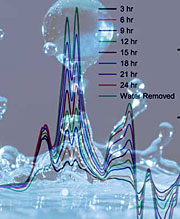- Number 346 |
- September 19, 2011
Water expedites the capture of climate change's chief culprit

A thin film of water more quickly
solidifies gaseous carbon dioxide,
according to a fundamental
study of the common pollutant.
A thin film of water more quickly solidifies gaseous carbon dioxide, according to scientists at DOE’s Pacific Northwest National Laboratory who are studying underground storage of the common pollutant. Keeping carbon dioxide from power plants deep underground and out of the atmosphere removes it as a player in climate change. But, would water be a bad influence on carbon dioxide while it was locked away?
The PNNL team found that nanometer-thick films of water coat the minerals and accelerate carbon dioxide solidification. When the films are thinner, the reactions are slower. By understanding the basics of sequestering carbon away from the atmosphere, scientists can inform industry and policymakers about the feasibility and safety of different options.
Funding was provided by DOE's Basic Energy Sciences Geosciences Program through a Single Investigator Small Group Research grant and the Carbon Sequestration Initiative, a Laboratory Directed Research and Development program at PNNL. Part of this work was done at EMSL, a national scientific user facility.
[Kristin Manke, 509.372.6011,
kristin.manke@pnnl.gov]
